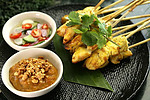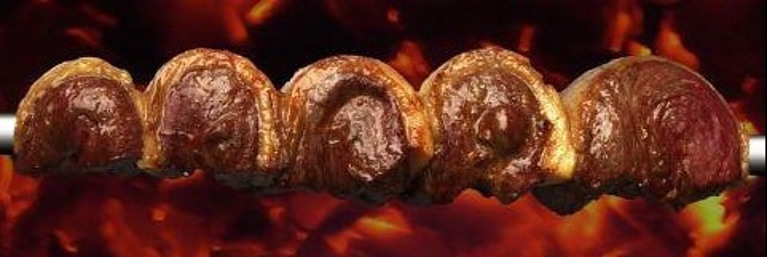As you can see in my post about Barbecue Styles in America, there’s a lot of variety in how barbecue is prepared and enjoyed across the country. What makes barbecue even more interesting, is that there are many other countries with their own barbecue traditions.
Whenever I visit a foreign country, I take time to explore these traditions as much as I can and then take that experience with me to see if I can replicate it at home. This tends to be a process of trial and error, but it’s very satisfying to be successful and share the results with friends and family.
Below I share information on barbecue food from a few different countries. Over time, I will post more details and recipes, so please check back in for future posts!
Barbecue in Brazil
A number of years ago, my wife and I lived and worked in Brazil for about a year, and we immersed ourselves in the language and culinary traditions of this beautiful country. The Brazilians we met were fantastic, many of them welcomed us into their homes for parties and introduced is to Brazilian barbecue.

The most famous cut of meat used in Brazil is picanha. Butchers in Brazil divide a cow differently than butchers in America, so the exact cut can be hard to find here. You can always do an internet search for your area or see if you can find the picanha meat cut at a local butcher. So, what cut of meat is picanha? It is cut from the top of the rump and sometimes called rump cover, rump cap or sirloin cap. In Brazil, the fat cap is usually left on to enhance the flavor.
In the US, barbecue is generally served on a plate with one or a few different meats. By contrast, a central idea in Brazil is to enjoy smaller portions of multiple meats and other barbecued food. You can experience this at Brazilian steakhouses, where different cuts of meat are grilled on a rotisserie. Waiters come to your table with the skewers and will cut a small piece of meat right onto your plate. For picanha, thick slices of meat are folded and put on a skewer as in the picture at the start of this post and then grilled. Notice that the fat cap is still on the meat; this makes it extra flavorful and deliciously juicy! At the restaurant, servers will cut you a slice of meat and then the skewer goes back on the rotisserie to sear the next layer.
At home, if you don’t have a rotisserie, you can use a similar approach. Cover a whole picanha in sea salt and grill it on all sides over charcoal. Cut it into steaks and sear those on both sides, then slice each steak into bite sized pieces. Guests can then take a piece of meat with a toothpick and eat it.
Barbecue in Indonesia

In Netherlands, where I grew up, there’s a big presence of Indonesian cuisine. One of the main Indonesian dishes is Satay (or sate), small pieces of meat grilled over charcoal on a skewer. I like to use metal ones that can be reused, but wood or bamboo works if they are soaked in water to prevent them from catching on fire. Common kinds of meat used are pork and beef, but chicken is also a great option. Before grilling, the meat is marinated in a marinade of soy sauce, chili paste (sambal), garlic, onions and vegetable oil.
If you can’t find sambal in the store, here’s an easy sambal recipe to make your own. Find some red chiles (Fresno’s are a good option) and mince them, add a little bit of salt and store the sambal in a jar in the refrigerator. In my opinion, this is even better than using store bought sambal, because it provides great freshness to the dish. This basic version is called sambal oelek, and there are other versions of sambal that are created by adding additional ingredients like dried shrimp paste (sambal terasi) or sugar (sambal manis).
Satay is served with a spicy peanut sauce. A quick satay sauce recipe is made with peanut butter, sambal oelek, sweet soy sauce, vinegar, salt and water and other ingredients can be added for different flavor profiles. Satay can be an appetizer as well as a main dish. It’s great with simple white or fried rice and some pickled vegetables.
Barbecue in Jamaica

One of the dishes that Jamaica is most known for is Jerk Chicken, which is chicken marinated in a paste of hot peppers and spices called jerk seasoning. For best results, the chicken must be in the marinade for at least 3 and up to 12 hours to get the most “jerk” flavor. Besides chicken, pork chops or seafood are a great option for this great dish as well.
You can make jerk seasoning at home, or purchase it premade at the grocery store or online. Basic ingredients are pimento, spicy peppers like scotch bonnet or habanero, scallions, onions and thyme. The seasoning can be made more complex by adding allspice, cinnamon, nutmeg and/or sugar. There are plenty of jerk seasoning recipes available, but these ingredients will give you great flavor and allow you to create your own “secret” recipe!
Preparation
All dishes described above are best prepared over charcoal for maximum authentic flavor.
Satay and picanha are cooked over direct heat only and seared quickly, so the entire grill should be hot.
For jerk chicken, it’s better to have hot coals on only one side of the grill. This way, you can cook the chicken on indirect heat with the lid on and then lightly char it over the hot coals at the end.
If you don’t have one, I recommend you buy charcoal grill, so you can enjoy the great flavor a real fire creates. The good news is that outdoor charcoal grills are among the more affordable grills on the market, so it’s not too hard to add one to your back yard or patio. I have an 18-inch Weber kettle that I bought about 10 years ago, and it still does a great job. The downside is that it holds only one good sized chicken or two small chickens or game hens, so if you want to prepare bigger meals you should get the 22- or 26-inch version. For more information on this grill, go ahead and have a look at my Weber Kettle Grill Review.
Conclusion
I hope you enjoyed this quick intro to international barbecue and look forward to any questions and comments. If you would like to know more about any specific type of barbecue, let me know and I’ll do what I can to create a future post around that.
Thank you for visiting and talk to you soon,
Herman

